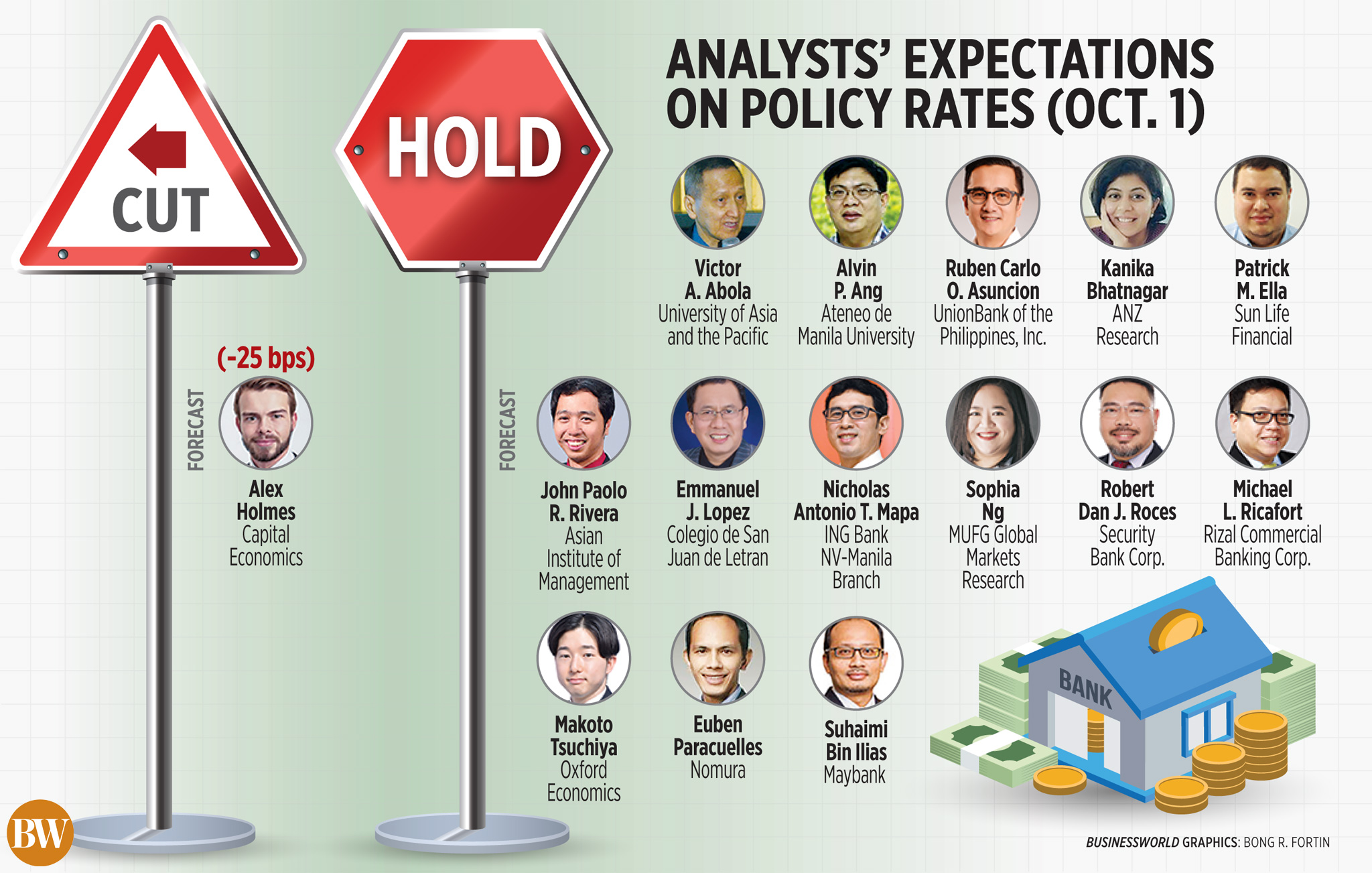
By Luz Wendy T. Noble, Reporter
THE Bangko Sentral ng Pilipinas (BSP) is widely expected to leave benchmark interest rates untouched on Thursday, as it reserves its measures in case economic recovery lags, analysts said.
In a BusinessWorld poll held last week, 14 of 15 analysts said they expect the Monetary Board (MB) to keep interest rates steady at its fifth policy-setting review on Oct. 1.
“I suspect that ‘enough liquidity’ would be the flavor of the discussion in this October’s MB meeting. The demand side has been obviously still lagging and the supply side is clearly very well supported,” UnionBank of the Philippines, Inc. Chief Economist Ruben Carlo O. Asuncion said.
Security Bank Corp. Chief Economist Robert Dan J. Roces said the Monetary Board will likely consider the third-quarter gross domestic product (GDP) report before making any policy adjustments.
After a record 16.5% contraction in the second quarter, the government expects third-quarter GDP to be slightly better. It is projecting a 4.5% to 6.6% drop in the economy this year.
The third-quarter GDP report will come out on Nov. 10.
“The interest pause is also to preserve monetary policy space in case the baseline expectations of shallowing recession in (second half) 2020 and rebound in 2021 fail to materialize,” Maybank Investment Bank Chief Economist Suhaimi Bin Ilias said.
BSP Governor Benjamin E. Diokno has said the central bank’s policy moves already infused some P1.4 trillion in liquidity, equivalent to 7.3% of the country’s GDP.
Despite this, bank lending has been tepid. In July, outstanding loans by big banks rose by 6.7%, easing for the fourth consecutive month and slower than the 9.6% expansion in June.
This further suggests that a rate cut is unlikely on Thursday, with the BSP likely to use other tools to provide much needed support during this crisis, said ANZ Research economist Kanika Bhatnagar.
“The insufficient transmission of cuts in the policy rate through the lending is a larger concern for now,” Ms. Bhatnagar said.
“We expect the central bank to provide support in other ways such as facilitating government borrowings and implement a loan moratorium to ease the debt servicing burden of borrowers,” she added.
Under Republic Act No. 11494, or the Bayanihan to Recover as One Act (Bayanihan II), banks and other covered institutions must implement a one-time, 60-day moratorium on all loan payments.
The law also allowed the BSP to directly lend up to 30% or about P850 billion of its average revenue to the National Government, higher than the 20% (or about P540 billion) of its average revenue allowed under the New Central Bank Act.
The BSP bought P300 billion in government securities with zero interest from the Bureau of the Treasury (BTr) under a repurchase agreement back in March.
“We think BSP will focus more on debt monetization for now after the cap for lending to the government was raised,” Mitsubishi UFJ Group Global Research analyst Sophia Ng said.
She also said the BSP is likely to leave the reserve requirement ratio for banks unchanged, with the next easing likely to come by the first quarter of next year.
At its Aug. 20 policy meeting, the MB kept rates on hold following 175 basis points (bps) of reduction earlier this year that brought down the overnight reverse repurchase, lending, and deposit facilities to record lows of 2.25%, 2.75% and 1.75% respectively.
Meanwhile, the reserve requirement for big banks has been cut by 200 bps to 12% while reserve requirements for thrift and rural lenders were slashed by 100 bps to 3% and 2%, respectively. The Monetary Board is allowed to bring down the rate by up to 400 bps this year.
Mr. Diokno earlier said the current policy stance may be kept for the next few quarters. He said the BSP still has bullets when needed and is committed to a “long-term low inflation regime” and will continue to do what they have done “for maybe another two years.”
Headline inflation in August stood at 2.4%, bringing the eight-month average to 2.5%. This is well within the 2-4% target set by the BSP but higher than the key interest rate of 2.25%.
Alex Holmes, an economist from Capital Economics, expects another easing this Thursday.
“We have penciled in a 25-bp cut, given the weakness of the recovery. As it stands we have one further rate cut penciled in after next Thursday, which would take the policy rate to 1.75%,” he said.
After Oct. 1, the Monetary Board has two more meetings this year — on Nov. 19 and Dec. 17.

